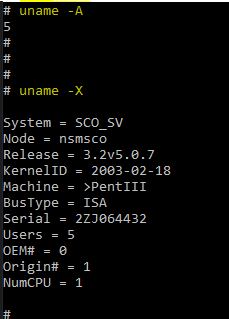Hi expert, I have a production server with OS SCO Unix where we are facing space issue.
We want to resize our mount points,could you please help me on this
Thanks.
Hi expert, I have a production server with OS SCO Unix where we are facing space issue.
We want to resize our mount points,could you please help me on this
Thanks.
You are asking how to resize a non-root filesystem that you want to shrink or enlarge?
If so, there are various utilities that allow you to alter a partition size and grow/shrink filesystems without backup/reformat/restore but you need to check that they work with SCO.
What type of filesystem is it?
@jgt will know how to do this better than me.
PS. Have you searched this forum for similar questions/answers. You should do.
Search and read for yourself whilst you are waiting for responses. Above thread is one example; there are more.
When I was stuck years (many) ago with system where you could not change the FS size, I used to create a new FS, mount on a tempo dir, and MOVE a complete subdir of the full FS in order to once completed ( the move - with "cpio" ) mount the new FS on subdir of now not so full FS... this took less than 10 minutes to do...
Thanks, could you ease help me how can we create new FS ,as I have never worked with Unix .
We have SCO Unix.
Hey @dchandra
This is the fundamental problem: that you have never worked with a unix or linux system.
First all all, before trying to do things like upgrade filesystems or burn new instances, you must understand what you have before you.
What is the exact hardware you are using? Details matter.
What is the exact software versions of the various key software applications on your system? Release dates? By whom?
Before you can solve problems you must first define your "problems" completely (as much as you can).
You seem to want to solve problems before you even have a basic understanding of the system you are working on.
This is why you are struggling so much.
If you are new to SCO Unix there is a scripted system admin shell. It depends how old your SCO version is as to what it's called.
See this:
Also, AFAIR, command 'divvy' will help you with partitioning, filesystem creation, etc.
However, no matter what tools you are introduced to, as @neo says, you need to familiarize yourself with SCO more. Searching for, and reading threads on this forum is a good place to start.
What is the output of 'uname -A'.
Can you post a screen shot of 'divvy', be sure to just 'q' and 'e'.
If you have a second hard drive do 'divvy /dev/rhd1a' as well.
Since you have BackupEdge, you can relatively easily restore a backup to a newly created partition.
Without the Veritas disk mirroring package, you cannot resize any file systems, you have to delete and re-create larger, which will destroy all the data in the old file system.
uname -a
SCO_SV v 3.2 5.0.7 i386

Hey @dchandra
Please post as @jgt requested earlier:
uname -A # note the capital A, not lower case a
and also, while you are at it (posting system information), kindly reply with:
uname -X # note the capital X, not lower case x
See also:
Reference:

Hi @dchandra
Thank you for that information.
As you know, your SCO OS version is over 17 years old, and is, of course, not support by SCO.
Your CPU, the Pentium III, well that was discontinued for desktop use in 2004:
Even after the release of the Pentium 4 in late 2000, the Pentium III continued to be produced with new models introduced until early 2003, and were discontinued in April 2004 for desktop units[3] and May 2007 for mobile units
Both your OS and your hardware should be retired and replaced.
Do you have a commercial application running on this "antique" machine?
If so, what it is, precisely?
Thanks.
My bad, I should have asked for 'uname -X' not '-A'.
My recommendation would be to install a second disk. You can get a 500gb or 1tb SSD for less than $200.
Install the disk, then do the following:
#mkdev hd
reboot
#mkdev hd
create one partition
create a new file system (user2)?
#run scoadmin->file systems , and add the new file system mount.
Determine how you can move some of the data from /user to /user2. You may be able to use symbolic links if it is necessary to maintain the present directory structures.
Hey @dchandra
Personally, I would not run a business process on a computer with software version which is 17 years old, and keep putting bandaids on the legacy system, unless I had a very good reason to do so.
That is why I asked about your application. It might be good to consider the pros and cons of migrating off an OS which is 17 years old and not supported (by the manufacturer) for a very long time.
Of course, you can continue to put bandaids on this unsupported legacy OS, and I have nothing against people like @jgt proposing their solutions to bandaid your system(s).
However, it is also good to look at the alternatives to moving off these obsolete and not vendor support operating systems (no patches, no security updates, etc).
Cheers.
Thanks All for your support. I will install second disk with enough storage and will move data in new storage.
This topic was automatically closed after 14 days. New replies are no longer allowed.